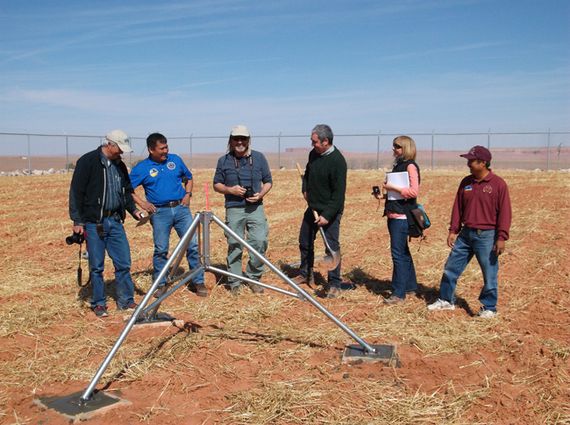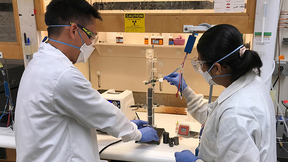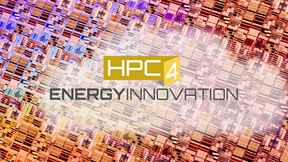Lab partners with Navajo Nation on uranium mine project
 (Download Image)
From left, Brad Esser, Gilbert Dayzie, Vic Madrid, Michael Taffet, Theresa Kayzar and Melvin Yazzie stand at the base of the meteorological monitoring equipment to be installed on the waste cell.
(Download Image)
From left, Brad Esser, Gilbert Dayzie, Vic Madrid, Michael Taffet, Theresa Kayzar and Melvin Yazzie stand at the base of the meteorological monitoring equipment to be installed on the waste cell.
A team of Lab scientists last month visited the Navajo Nation Abandoned Mine Lands Reclamation Project (Navajo AML) in Shiprock, N.M. to conduct work on a joint project. The partnership will develop an environmental and hydrological monitoring program for a uranium mine waste disposal cell in the Tse Tah area of northeast Arizona and several other mining areas.
The Lab team, comprised of radiochemists Brad Esser and Theresa Kayzar, along with contaminant hydrogeologists Victor Madrid and Michael Taffet, was hosted by Navajo AML, the organization responsible for protecting, restoring, enhancing and reclaiming abandoned mine sites on Navajo lands and ensuring that any resulting surface water and ground water contaminants are addressed in accordance with applicable cleanup standards.
AML excavated and disposed of Tse Tah mining waste locally in the engineered Morrison waste cell. The waste cell has an impermeable liner and leachate collection drainage system; the upper portion (several feet) is composed of compacted clean locally-derived fill dirt designed to evaporate rainfall and run off water and prevent it from seeping into the underlying waste layers.
LLNL has designed a soil moisture monitoring system to assist AML in evaluating the effectiveness of the waste cell design and will assist Navajo AML in evaluating the resulting soil moisture and meteorological data; reviewing existing environmental data; developing a comprehensive plan for evaluating mine waste remediation performance; developing soil, air, and water sampling and analysis plans, defining field soil radiation survey equipment; and recommending chemical and radionuclide analyses for Tse Tah and other mining areas.
The LLNL team is providing assistance in developing protocols and procedures to conduct environmental assessments as mandated by U.S. Environmental Protection Agency guidance and in developing an education program for local college students. This work is funded through 2013 and additional funding is being requested by Navajo AML to enable the LLNL team and their staff to complete this project.
The LLNL team visited the reclaimed uranium mine sites at Tse Tah, including the Morrison uranium waste cell. They also assisted in the installation of the soil moisture probes into the landfill. The visit concluded with a technical meeting with Navajo AML engineers, scientists, technicians, regulators, and senior managers to plan next steps in the collaborative project.
LLNL team members said they were impressed by Navajo AML's engineered approaches to isolating mine waste from water and the environment, the technical challenges they continue to face, and the enthusiasm and skills they display in accomplishing their mission. The LLNL team also is striving to develop additional initiatives for promoting LLNL resources to obtain additional funds for research and applied scientific collaborations with universities in tackling other uranium problems on Navajo Nation lands.
Contact
Linda A Lucchetti[email protected]
925-422-5815
Tags
EnergyFeatured Articles







